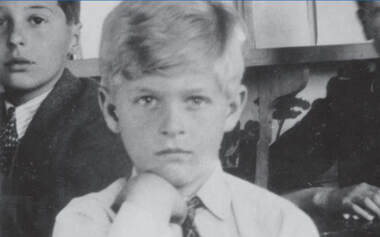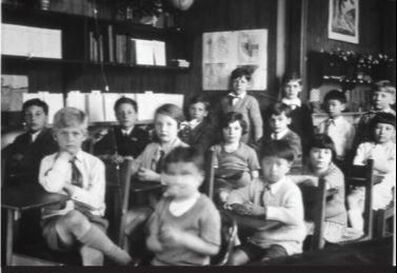
|
The Duke of Edinburgh was rescued from a traumatic childhood. Donald MacJannet may deserve much of the credit. From Les Entretiens, Spring 2012 BY DAN ROTTENBERG Donald and Charlotte MacJannet molded several subsequently famous figures during their formative years, among them the late Indian Prime Minister Indira Gandhi and the late U.S. Supreme Court Justice Potter Stewart. But the MacJannets’ best-known alumnus has long mystified devoted MacJannet acolytes, not to mention many of his subjects. The Duke of Edinburgh, now the 90-year-old consort of Britain’s Queen Elizabeth II, was enrolled at Donald MacJannet’s school outside Paris in 1927, when he was a six-year-old with the less grandiloquent (if equally baffling to his classmates) name of Philip of Greece. Donald MacJannet’s approach to education, as we know, relied heavily on offering children a warm and welcoming environment as well as exposure to foreign cultures, the better to sensitize them to respect other people’s differences. Yet Philip’s public image, as London’s Telegraph put it recently, is that of a man who “has become notorious for making public gaffes” and “has gained rather a reputation for embarrassing comments and questions while on royal tours of duty.” MacJannet disciples may be tempted to wonder: In Philip’s case, did Donald MacJannet’s formula fail? Or, conversely, is there more to Philip’s story than the figure so often ridiculed in the tabloids? A recent biography of Prince Philip suggests emphatically that the answer is the latter. In Prince Philip: The Turbulent Early Life of the Man Who Married Queen Elizabeth II (Henry Holt, 2011), author Philip Eade reminds us that Philip overcame an inconceivably traumatic childhood. Smuggled out Although Philip was born in Greece to the Greek royal family, he was mostly Danish (the Greeks recruited his grandfather, a Danish prince, to be their king in the 19th Century), with German and English thrown in. When he was just a baby, a revolution ran his royal family out of Greece. Philip himself was smuggled out in a fruit crate in 1922, as his father, Prince Andrew of Greece and Denmark, evaded execution. Philip’s mother, Princess Alice of Battenberg, was born deaf; she was committed to a psychiatric clinic when Philip was eight. His father, already traumatized by his exile from his home country, shut up the family home and went off to live with his mistress, effectively leaving his young son an orphan. Thus by the time Philip was a teenager, he had lost his home, his name and identity, his family and many of his close relatives. Shuttled around to various relatives and boarding schools in Germany and Britain, Philip grew into a tough young man. Yet this smart, robust, take-charge aristocrat somehow managed to subordinate his alpha male instincts to play a lifelong supporting role to his wife— fathering her heirs, organizing her palaces, avoiding politics, and always walking a few paces behind his wife for the rest of his life. When Philip is viewed in this light—as a stable rudder for the British monarchy—the relevant question becomes: Does Donald MacJannet deserve some of the credit? Baseball before Cricket Eade’s book doesn’t address the question directly but does provide grounds for speculation. Philip spent three years at the MacJannet School—from age six to nine. Although most educators today stress the critical importance of early childhood education in shaping personality, Eade devotes just three pages to Philip’s time at the MacJannet School, which Eade describes as “a progressive American kindergarten housed in Jules Verne’s former home— a rambling old St. Cloud mansion (also since demolished) at 7 Avenue Eugenie just above the Seine, opposite the western end of the Bois de Boulogne, and shaded by the large trees that gave the school its name: The Elms.” In some respects, Philip’s exposure to foreign classmates worked just as Donald MacJannet intended. “The majority of his classmates were American,” Eade reports, “and Philip picked up something of their drawl and learned to play baseball before he played cricket. He coveted anything that came from the New York department store Macy’s and was only too pleased to swap a gold bibelot given to him by George V for a state-of-the-art three-color pencil belonging to another boy.” Chinese friends Eade quotes one of Philip’s teachers as being struck by the young prince’s precocious sense of responsibility. Having walked to school with his nanny, she recalled, he usually arrived there half an hour early, and he would fill in the time cleaning blackboards, filling inkwells, straightening the classroom furniture, picking up waste paper and watering the plants. On his first day at The Elms, Eade reports, “some of the other boys had demanded that Philip ‘fight it out’ with another new boy. After a brief scuffle, he whispered to his opponent, ‘Are you having fun?’ When the other boy admitted he wasn’t, Philip said, ‘Let’s quit,’ which they did.” “He wanted to learn to do everything,” Eade notes, “including waiting at table, his mother having taught him that ‘a gentleman does not allow a woman to wait on him.’ He also appeared to take for granted his mother’s insistence on hard work: Alice [his mother] made him do extra Greek prep three evenings a week, and asked the school to set him a daily exercise for the holidays.” When Philip first arrived at the Elms, Eade writes, “Alice had told the headmaster that her son had ‘plenty of originality and spontaneity’ and suggested that he be encouraged to work off his energy playing games and learning ‘Anglo-Saxon ideas of courage, fair play and resistance.’ She said she envisaged him ending up in an English-speaking country, perhaps America, so she wanted him to learn good English….. Alice also wanted Philip to ‘develop English characteristics’.” Biographer’s trap Eade readily acknowledges that “The accounts we have of Philip’s time at the school all emerged after his engagement to Princess Elizabeth and thus they may have been embroidered with the benefit of hindsight.” Whatever the explanation, Eade falls into the common biographer’s trap of focusing on the manner in which characteristics are transmitted from parents (in this case Philip’s mother, Alice) to children. But the blessing of an outside patron or mentor— uncluttered by familial or Freudian issues— is equally essential. The teacher Anne Sullivan— not Helen Keller’s parents— was Keller’s “miracle worker.” Was Donald MacJannet Prince Philip’s “miracle worker”? Eade doesn’t speculate. But anyone who was exposed to the MacJannets as a child must wonder how receptive another headmaster would have been to the suggestions of a mother— especially a mother like Philip’s, who was not only deaf but also, in 1927, teetering on the brink of insanity. Link to Gordonstoun
According to Schoolmaster of Kings, Herbert Jacobs’s unpublished biography of Donald MacJannet, Prince Philip later described his time at the MacJannet school as “three of the happiest years of my life.” Jacobs further suggests that Philip’s experience at the MacJannet School may have been part of the reason why he later sent his son Prince Charles to school at Gordonstoun in Scotland rather than having him tutored, as previous Princes of Wales had been. Philip himself attended Gordonstoun after it opened in 1934. Donald MacJannet was said to have been friendly with Gordonstoun’s founder, the German educational reformer Kurt Hahn, and perhaps could have influenced Philip’s decision to enroll there. In 1956 Philip created the Duke of Edinburgh’s Award, a prize for young people (age 14 to 24) whose criteria seem to have been taken directly from Donald MacJannet’s syllabus: It honors such activities as volunteer service, physical development, social and personal skills, adventurous journeys and participation in a shared activity while living away from one’s home. “Taking part builds confidence and develops self esteem,” the program’s website explains. “It requires persistence, commitment and has a lasting impact on the attitudes and outlook of all young people who do their D of E.” That comment is unsigned, but it could have been written by Philip himself, referring to his experience at The Elms.
7 Comments
|
© 2019 MacJannet Foundation. All rights reserved.
MacJannet Foundation
396 Washington Street, Suite 200
Wellesley Hills, MA 02481
MacJannet Foundation
396 Washington Street, Suite 200
Wellesley Hills, MA 02481


